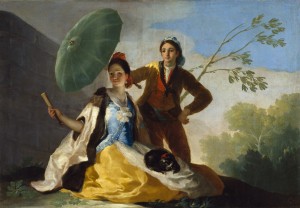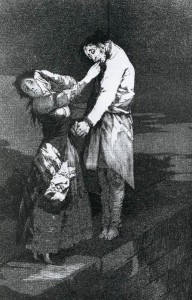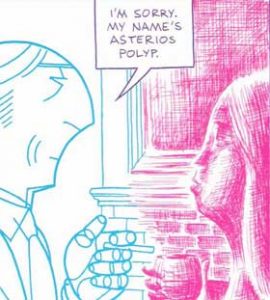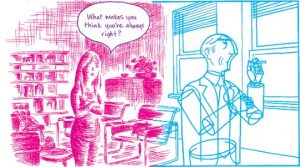I really liked the wordless-ness of The Arrival and how it conveys the perspective of an immigrant. When the man shows up in this crazy new world, he is on his own, unable to speak or understand the native language. The lack of text reflects the loneliness he experiences, a kind of silence he endures daily. It also conveys a sense of other-worldliness as we discussed in class. There are so many befuddling and fantastic sights, that this absorbs the man’s attention. On another level, the lack of text draws the reader’s full attention to the illustrations and the sequence of pictures, because these pictures are the sole carrier of the responsibility of telling the story.
Author: Ellie Miller
Division in Asterios Polyp
I loved the variety of artistic styles in Asterios Polyp. Many of the pages are divided by shape, style, or color. One example is the page where Asterios Polyp introduces himself to Hana. His side of the page is blue, with a lot of empty space, and his body is very blocky and broken apart. Hana’s side is pink, sketchy, and contains shading. The severe difference between the two characters makes it seem like they’re in two different rooms, or worlds even.
This other illustration is brilliant, because it shows Hana asking, “What makes you think you’re always right?” The emotional division between the two is very clear in the differing colors and styles. This is one aspect of David Mazzucchelli’s art that I find very expressive, and really enjoyed.
Collaging Evolution
For this week’s collage workshop, I decided to go scientific and attempt to portray Charles Darwin’s discovery of natural selection! I decided to use a chapter from my biology textbook, which mentioned Darwin’s fascination with birds, specifically finches. The scientist studied the anatomical differences, such as beak size, between birds on the Galapagos Island. I found a magazine on birds, which contained a lot of beautiful nature photography, but I also used wings from silly ads and feathers from a picture of a tattoo. It was great having a variety of magazines to pull pictures from, because I almost feel as if collages look more put-together when the clippings are different. It’s the challenge of creating your own image and story out of pieces of someone else’s story. I definitely need to experiment a lot more before I can say I have mastered collage.
Amphigorey
I can’t believe I had never heard of Amphigorey (or even Edward Gorey) before in my life, because I think his work is fantastic. The Object-Lesson is one I find especially mysterious, because things seem to happen randomly, completely without order or reason. Maybe there is a comment somewhere in there about our society and how we act and react crazily to things we shouldn’t (Madame O flings herself over the parapet after realizing that her cousin’s mustache is not his own). One page reads, “On the shore a bat, or possibly an umbrella, disengaged itself from the shrubbery, causing those nearby to recollect the miseries of childhood.” In class we learned that Gorey was very uncomfortable around children, which makes me wonder what his childhood was like. Although I hope he didn’t personally connect to the grim fates presented in The Gashlycrumb Tinies, something must have inspired him to view kids as vulnerable to horrible experiences.
The Very Hungry Caterpillar
Eric Carle’s The Very Hungry Caterpillar was one of my favorite picture books from my childhood, and seeing it in class made me think about how we perceive the art in children’s books. Children’s books are so incredibly wonderful for so many reasons, and so many have stuck with me, so I decided to write my final paper comparing Goya to a favorite book of mine (and of the world in general), Dr. Seuss’ The Lorax. I think writing this essay will open my eyes in a new way to picture books, because it will force me to compare one to the very dark and mature artwork of Goya. Who knows what I will find…. Maybe there are more similarities than meet the eye?
Yun-Fei Ji in Science and Literature
This week, I had the privilege of hearing from Yun-Fei Ji in two very different contexts. First, my Global Warming class visited with him to hear about the Three Gorges Dam. His painting of the Dam was relevant to us because of our focus on renewable energy and the role of the government in the environment. The next day, our Lit class visited him to have an interesting discussion about his art, scrolls, culture, and inspiration. I really enjoyed hearing Yun-Fei speak about his work in terms of the environment/society and then in terms of artistic choices. He’s clearly a super thoughtful, smart person whose art means a lot to him. He did a lot of research, including traveling to China when he heard about the Dam project. After learning about the impact this dam would have on the communities living nearby, he wanted to create a painting that made a critical statement about the government. I think he’s made others making risky statements about the government, like the long horizontal scroll we saw depicting the peach trees. You could especially sense his desire to create art with meaning that exposed the truth when one classmate asked him, “Did you expect your artwork to be so controversial?” And he replied, “That’s very flattering!”
Warning: The Sleep of Reason Produces Monsters
The Sleep of Reason Produces Monsters (43) by Goya is no doubt a chilling image. The animals hover over the man, seemingly a representation of the fears within his mind. The shadowy bats’ creepiness, the owls’ screeching faces and wide eyes, and the glowing glares of two lynxes do a fantastic job of instilling fear. The scary creatures in our nightmares terrify us when we sleep, but sometimes they represent actual stressors which affect us in real life. The owl directly to the left of the man’s head is clutching one of his tools, maybe a magnifying glass. Goya takes this print to the next level by making the owl physically interact with the man’s life. One of his fears, represented by this owl, is so severe that it has crept into reality, perhaps interfering with his work. I think Goya might have been depicting the human tendency to keep certain fears buried within our minds until they get so bad that they start noticeably affecting us. Worse still, I noticed that the black lynx or cat at the center of the image is not attacking the man or even looking at him: it’s looking at us, the reader, crouched as if ready to pounce. Perhaps Goya is sending us a warning to confront our fears head-on before they take control of us and put us in danger.
Goya
The most fascinating thing I learned about Goya was his transition from traditional painting to the aquatint found in Los Caprichos. Observing this change, you can really gain insight into his own personal experiences and how these affected his outlook on life. Comparing something like The Parasol which he did in 1777 to something like Out Hunting for Teeth which he did in 1797-1798, you might not even believe that the same artist was responsible. The rich colors versus the etching and the different emotions you can draw from these works are amazing. I see The Parasol as an image of traditional beauty: a sunny day, a handsome young man and a beautiful, smiling young woman decked out in a luxurious dress with a snoozing puppy on her lap. There is not a care in this world, no sense of danger, and a calm, content feeling. In Out Hunting for Teeth, we see terror, death, suffering, and get an overall grotesque feeling. Goya’s art provides a unique look into his transforming reactions to the world around him. 

Gold leaf
Creating an illuminated letter is not easy. I came in with some basic ideas of what to draw, but when I changed my mind about what letter I wanted to do, I had to start fresh. I could not come up with any interesting ideas, so I flipped through books for a while to find inspiration. However, once I got started (and with Gregorian chants in the background), I felt very focused on my letter. During the process, I noticed that I began thinking about each piece of the letter as its own part, trying to perfect the curves and colors in that one area. This is why my letter turned out a little disconnected – it doesn’t flow like the ones we’ve seen in class.When it came to applying the gold leaf, I was hopeless. I’m sure the application process was different in the medieval times, but this was challenging! The gold wouldn’t peel correctly, and ended up sticking in areas I didn’t want it to. This part was of the process was difficult, but it made me laugh because I realized how much more difficult it must have been for an illuminator who took his work so seriously. I really enjoyed the scriptorium project and liked this different kind of class.
Blindness
When Black visits Head Illuminator Osman, the great master tells him that there are three questions he would ask to find out how genuine a painter is. The last one is blindness: “Blindness is silence. If you combine what I’ve just now said, the first and the second questions, ‘blindness’ will emerge. It’s the farthest one can go in illustrating; it is seeing what appears out of Allah’s own blackness.” (pg. 60) I was fascinated by this quote but it reminded me of something in the beginning of the book, way back on page 26: “Near the ‘Burnt Column,’ I saw some bothersome beggars dressed in rags huddling together as the smell of offal coming from the chicken-sellers wafter over them. One of them who was blind smiled as he watched the falling snow.” (26) I remember re-reading that line several times at first to try to understand it, but I could not. Now I think I might – now I see the beggar as an illuminator. Because he only sees blackness, he must have to imagine everything he remembers seeing, and I think he smiles because he appreciates everything so much more. He no longer gains happiness from what he sees around him, so all his happiness has to come from within him and his own imagination. This is similar to a genuine painter in Osman’s eyes, who must be inspired from what appears in the blackness. It’s such a unique concept and makes Pamuk’s writing all the more stunning for me.


